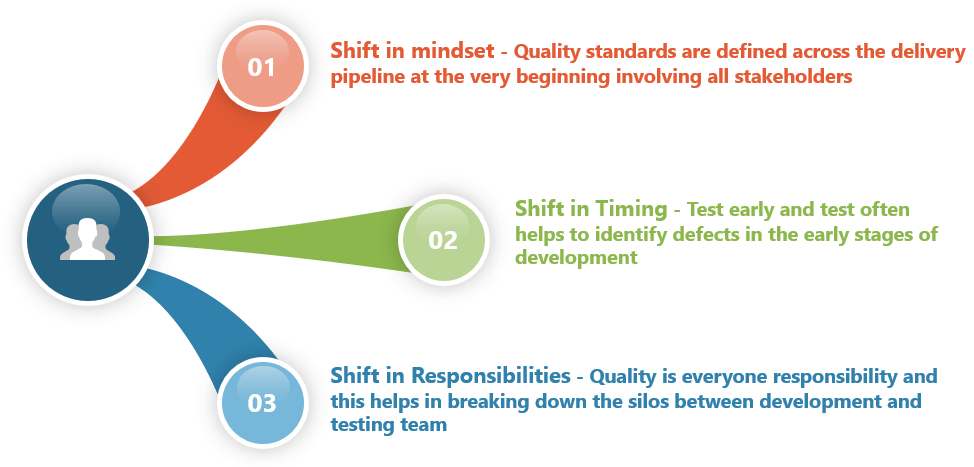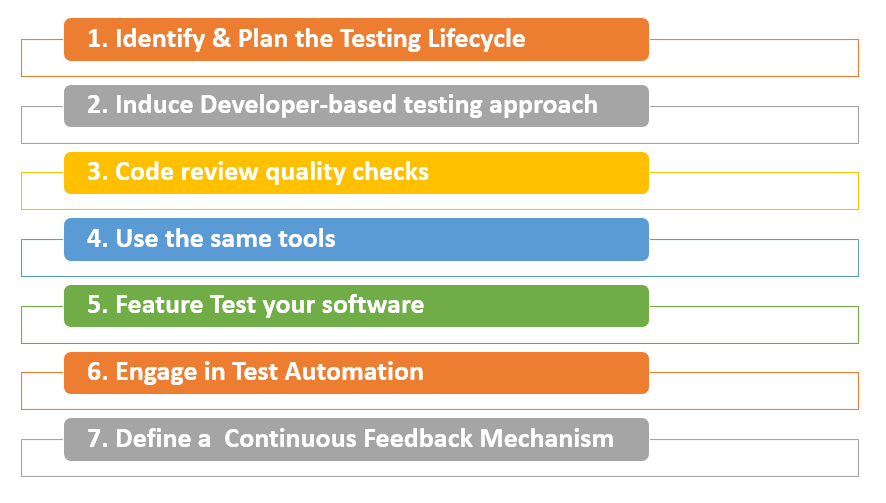
Shift Left Testing : How to Get Started | Webomates
The Goal of Shift Left Testing
Have you ever experienced a project running into budget issues, schedule slippages and getting delayed due to some last-moment defects? These issues are so common so the answer is, probably yes!
The need to implement large, business, and customer-critical systems in an environment driven by short timelines and tight budgets has led to a change in methods that deliver business value quickly. One such method is Shift-Left Testing.
This article will also answer a very important question – Why does DevOps recommend shift left testing principles?
It is 15 times costlier to fix defects in the test phase of a waterfall project because testing occurs later in the project development lifecycle.
IBM SYSTEM SCIENCE INSTITUTE REPORT
Relegating the entire testing to the last stage just before deployment is no longer feasible.
So, how do we fix this? The answer is simple – Shift Left your entire Testing!
According to Larry Smith – who coined the term Shift Left Testing – “Bugs are cheaper when caught young!” The Shift Left testing approach uses the ‘test early and often’ mantra to perform testing earlier in the life cycle (thereby moving left on the project timeline). The goal is to prevent defects and mitigate risks rather than deal with a whole load of bugs and critical issues post-development. Shift Left testing avoids cost overruns and project delays.
Do you really need to Shift-left your testing?
If you answer ‘Yes’ to all these questions, Shift left is the key!
- Do you want to automate different testing types like Unit Testing, Functional Testing, API Testing, Security Testing?
- Do you want to start feature testing at an early stage to ensure quality releases?
- Do you want to detect defects early in the development lifecycle?
- Do you want a smaller and quicker feedback loop between the development and testing teams?
- Do you want to have maximum test coverage of your functionalities?
How can you Get Started With Shift Left Testing
Shift left does more than just help teams find defects early. To shift left means a change in organizations culture.

Now let’s find out what your teams need to do to get started with shift left testing.

- Identify Plan the Testing Lifecycle
Planning is an integral part of the shift left approach. Shift left works best when the Test analysts identify and plan the entire testing lifecycle before the start of the actual development process. This provides a strong starting point for all activities in the test lifecycle, and will help all business and operational stakeholders, developers and testers understand the tasks, objectives and expected outcome from the project.
One way of doing this is by identifying testing requirements right from the project planning and requirements specification phase. Test planning includes budget, resources, testing strategies, and other project requirements. This helps teams focus on quality from day one of the project, rather than waiting for defects to be uncovered late in the software development lifecycle.
- Induce Developer-based testing approach
The main role of a developer is to code new features or enhancements as per the requirements. However, testing is no longer an activity that is done by a tester.
As the developers are most familiar with their own codes, they can rigorously test their code to rule out any errors and check the application’s functionality. It is also important to ensure that the new code does not give rise to any defects when integrated with the application’s existing functionality. So testing the code as soon as it is developed ensures quicker defect identification. It expedites the process of exposing and fixing coding errors. It helps in reducing uncertainty in a unit. Development testing aims to eliminate coding errors before the code is passed on to the QA team. A perfect blend of both Developer-based and QA-based testing would ensure easy defect identification along with quality feature release.
- Code review quality checks
Collaboration is the key to success. To ensure higher code quality, all developers must agree to conform to the same coding standards.
With the developers now contributing to the testing efforts, the testers can focus on defining quality checks for the developers’ scripts and to focus on exploratory, security, and performance testing.
- Use the same tools
One of the major issues faced by the testing team is the inability to create automated tests using the same tools as used by the developers. This becomes a roadblock for testers creating the automation framework. A best practice is to use the same technology stack that the developers are using.
- Feature Test your software
Feature Testing is the process of making changes in a software to add new features or to make modifications in the already existing features. Testing these features is extremely important and delivering software incrementally necessitates the Development and QA teams to work collaboratively to deliver a build.
For every incremental build, Webomates CQ, our cloud based testing platform can create, execute, maintain, analyze test cases and generate defects for browsers, mobile, Windows and API applications. Exact state of the system in terms of bugs is known after every check in. With stringent code quality checks, the defects are detected at an early stage hence are easier to fix, ultimately resulting in improved quality of each feature.
- Engage in Test Automation
In this DevOps driven landscape, it is highly recommended to adopt test automation in order to avail maximum benefit out of Shift Left testing. With test automation, developers and testers can automate the entire build to test process across all the stages of software development.
It’s not just about having test automation. The issues that need to be addressed are:
- Coverage: How much automation?
Defining a smart test strategy holds the key to successful automation testing. Here is the list of factors that can help you to determine whether you should automate a test case or not:
- Automation complexity
- Average script creation time
- Desired speed of regression
- Frequency of releases
- Stability of the build
- Rate of change/addition of test cases
- Healing: How up-to-date are the test suites?
Intelligent Test Automation is the key! When new changes are introduced, either by the developer due to the ever-changing requirements or during the integration or build process, there is a chance that the automation may fail due to the predefined test scripts. It is then very difficult to identify which test cases should be modified or added. Click to know more about this article: Shift left testing
Shift left testing Services | Requirement traceability matrix | Api testing | Adhoc testing





